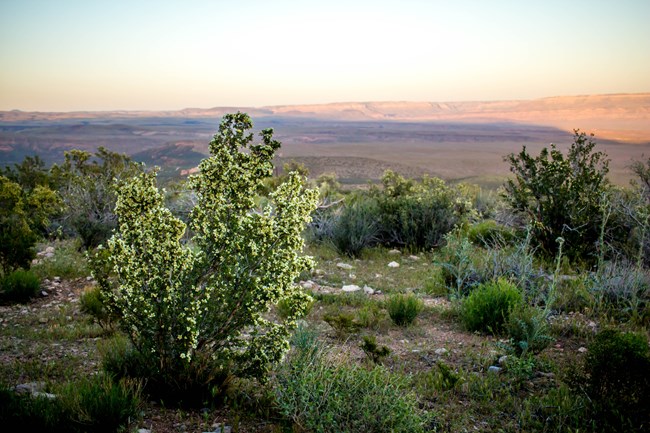
NPS/ T. Miller Mohave Desert Scrub contains low growing plants that are dominated by creosote and blackbrush, and towered over by Joshua trees. The slopes often contain prickly pear, cholla cactus, barrel cactus and many other shrubs. Wet winters provide the necessary moisture for numerous annual wildflowers to grow between the low-lying shrubs. Brilliant red, orange, yellow and purple wildflowers attract pollinators and predators such as the Desert tortoise, mule deer, and rabbits. Soil conditions, wind, fire, drought, and little shade make the semiarid west along meridian suitable growing conditions shrublands. Sometimes categorized as trees or herbaceous plants these hardy specimens have evolved over geologic time into the plants we see today. Sagebrush, blackbrush, creosote, yucca, scrub oak, pinyon-juniper and many other plants found in shrublands have adapted overtime to withstand the harsh conditions present in their environment. The arid environment of shrublands supports a variety of fire-resistant plants. Adapted to drought like conditions, many of these plants wait for the late summer monsoon rain for growth and reproduction. Cheat grass, an exotic plant to North American, threatens shrublands as it covers the bare ground producing a blanket of fine fuels. The natural spark of lightening or a match carelessly tossed away can easily light the fuel creating a catastrophic fire. Shrublands are categorized as early succession habitats that over time, give way to forests. These areas of abundant shrubs may occur either naturally or as a result of human activity, such as livestock grazing. Plants that grow in shrublands are usually quick to regenerate from their roots, reclaiming their place in the alkaline soil, or on steep and rocky slopes. Shrublands are important habitat for many animals including lizards, snakes, rabbits, and squirrels. Many bird species depend shrublands for nesting and raising their young. Berries and seeds provide adequate food while the thick woody branches of sagebrush and other shrubby plants allow the animals to conceal their young from predators. |
Last updated: January 9, 2020
